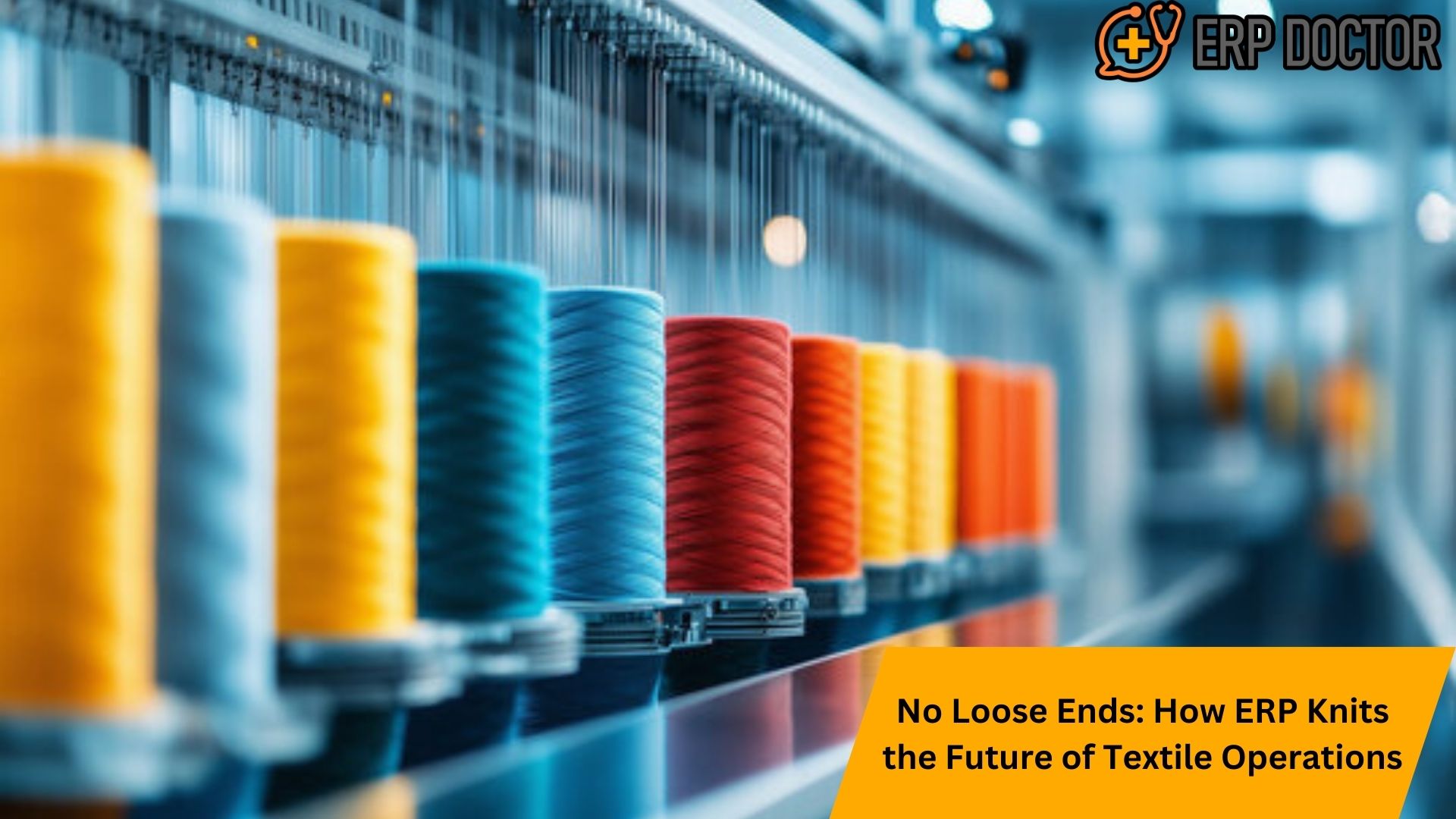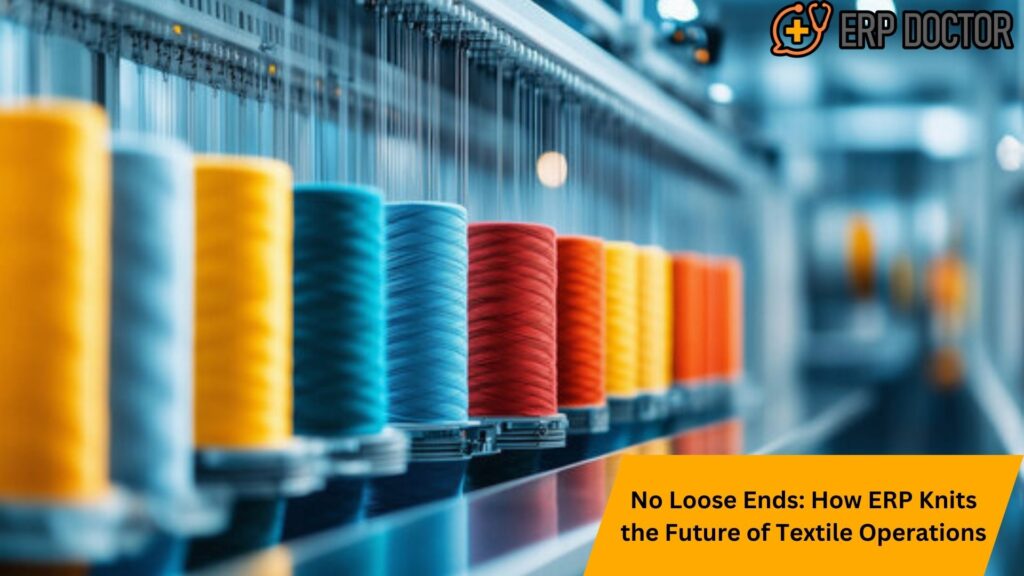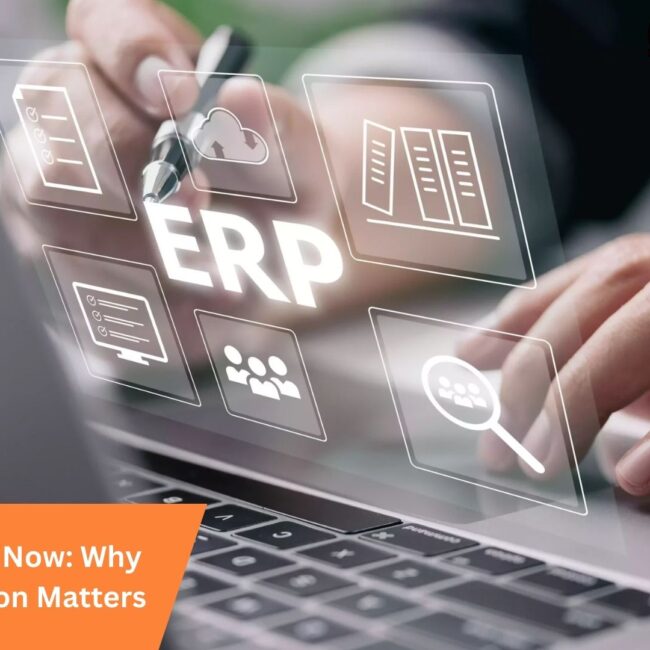
No Loose Ends: How ERP Knits the Future of Textile Operations

How ERP Knits the Future of Textile Operations
The Textile industry is undergoing a digital transformation, and ERP (Enterprise Resource Planning) plays a pivotal role in ensuring smooth, efficient, and scalable operations. From supply chain management to production tracking, ERP solutions are revolutionizing how textile manufacturers operate by reducing waste, improving quality control, and boosting overall productivity.
The Need for ERP in the Textile Industry
The Textile industry faces unique challenges such as fluctuating raw material prices, supply chain disruptions, production inefficiencies, and quality control issues. Implementing a robust ERP system helps textile businesses overcome these challenges by streamlining operations, automating processes, and ensuring data-driven decision-making.
Key Benefits of ERP for Textile Businesses
1. Efficient Inventory Management
ERP ensures that textile businesses maintain optimal inventory levels, reducing stockouts and overstocking. With real-time tracking, businesses can efficiently manage raw materials, semi-finished, and finished products.
2. Seamless Supply Chain Coordination
An ERP system integrates with suppliers and vendors, enabling better demand forecasting and reducing lead times. Textile companies can minimize disruptions and ensure smooth production cycles.
3. Improved Production Planning
ERP software provides insights into production schedules, helping manufacturers optimize resource allocation and minimize downtime.
4. Enhanced Quality Control
Quality assurance is crucial in textiles. ERP helps track defects, maintain standards, and ensure that only top-quality products reach the market.
5. Cost Reduction and Profit Maximization
By eliminating manual errors, reducing waste, and optimizing processes, ERP solutions significantly cut operational costs while maximizing profitability.
6. Regulatory Compliance & Sustainability
The textile industry must adhere to environmental and labor regulations. ERP systems help businesses track compliance, ensuring they meet global sustainability standards.
How to Choose the Right ERP for Textile Operations
Not all ERP solutions are created equal. When selecting an ERP for textiles, consider these factors:
- Industry-specific features like batch tracking, dyeing management, and fabric inspection.
- Scalability to accommodate future growth.
- Integration capabilities with existing software like CRM and e-commerce platforms.
- User-friendly interface for easy adoption by employees.
- Robust data analytics for real-time reporting and insights.
Implementing ERP in Textile Businesses
A successful ERP implementation requires careful planning and execution:
- Assess Business Needs: Identify pain points and define goals.
- Choose the Right ERP: Evaluate vendors and select a system tailored to the textile industry.
- Train Employees: Ensure smooth adoption through hands-on training.
- Monitor and Optimize: Continuously track performance and make improvements.
Overcoming Common ERP Implementation Challenges in Textile Businesses
Implementing ERP in the textile industry comes with its own set of challenges. Some common obstacles include resistance to change, high implementation costs, and integration complexities. Businesses can overcome these challenges by ensuring proper employee training, selecting cost-effective cloud-based ERP solutions, and working with experienced ERP consultants. Additionally, having a phased implementation approach allows companies to gradually adapt to the system while minimizing disruptions.
By embracing ERP technology, textile companies can future-proof their operations, ensuring efficiency, cost savings, and sustainable growth.
The Role of Cloud-Based ERP in Textile Manufacturing
Cloud-based ERP solutions are transforming the Textile industry by providing flexibility, real-time data access, and scalability. These systems eliminate the need for expensive hardware, making them a cost-effective option for small and medium-sized textile businesses. Cloud ERP also enhances collaboration across different departments, ensuring seamless communication between production, inventory, and supply chain teams.
How AI and IoT Enhance ERP in the Textile Industry
The integration of Artificial Intelligence (AI) and Internet of Things (IoT) with ERP is taking textile manufacturing to the next level. AI-driven analytics predict market trends, optimize production planning, and reduce downtime. IoT-enabled devices provide real-time monitoring of machinery, reducing maintenance costs and improving efficiency. These advancements ensure that textile businesses stay competitive in a rapidly evolving market.
By embracing ERP technology, textile companies can future-proof their operations, ensuring efficiency, cost savings, and sustainable growth.
FAQs
1. How does ERP help in fabric production tracking?
ERP provides real-time visibility into fabric production stages, helping manufacturers monitor raw material usage, quality, and production timelines.
2. Can ERP improve textile waste management?
Yes, ERP optimizes resource utilization, minimizes production waste, and ensures eco-friendly manufacturing practices.
3. Which ERP modules are essential for textile companies?
Key modules include inventory management, supply chain, production planning, quality control, and compliance tracking.
4. How does ERP enhance textile supply chain efficiency?
ERP integrates supplier networks, automates procurement, and reduces lead times, ensuring a smooth supply chain.
5. What are the cost benefits of ERP in textiles?
ERP reduces manual errors, cuts production downtime, and streamlines operations, leading to significant cost savings.
6. Can small textile businesses afford ERP?
Yes, cloud-based ERP solutions offer cost-effective options for small and medium-sized textile enterprises.
7. How does ERP support compliance in the textile industry?
ERP helps track environmental, labor, and safety regulations, ensuring compliance with industry standards.
8. What challenges can ERP solve in textile manufacturing?
ERP addresses challenges like order delays, inventory mismanagement, quality control issues, and inefficient production planning.
9. How long does ERP implementation take for a textile business?
Implementation timelines vary but generally take 3–6 months, depending on business size and customization needs.
10. How can textile companies measure ERP success?
Success is measured through improved production efficiency, reduced costs, enhanced quality control, and increased profitability.
By integrating ERP systems, the Textile industry can achieve operational excellence, ensuring long-term success in an increasingly competitive market.







